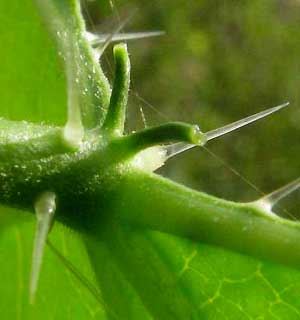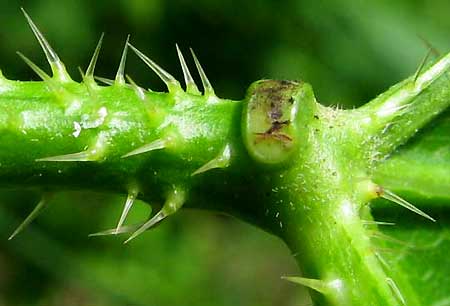
Often at woods edges and along roads you see a scraggly bush or small tree with big, maple-like leaves. That's one shown below:

 Usually the plant is called, even by English speakers, Mala Mujer (moo-HERR), which means, "bad woman." The plant is "bad" because it abundantly bears many stiff, sharp, stinging hairs of the kind northern nettles have, except that they're much larger and more painful to make contact with. Some stem prickles are shown at the right.
Usually the plant is called, even by English speakers, Mala Mujer (moo-HERR), which means, "bad woman." The plant is "bad" because it abundantly bears many stiff, sharp, stinging hairs of the kind northern nettles have, except that they're much larger and more painful to make contact with. Some stem prickles are shown at the right.
I don't know why the name givers made this plant a woman instead of a man, for it seems to me that men are more likely to be prickly than women.
Whatever the gender issues, it took me awhile to realize that in the Yucatan there are two, not one, very closely related species of "Mala Mujer." The species shown here is Cnidoscolus souzae. The other species is Cnidoscolus aconitifolius, which is a very important one because it's the wild ancestor of the wonderful Chaya plant that produces very nutritious leaves often used in traditional Maya cooking. We look at Chaya elsewhere.
 The two closely related species are a little hard to distinguish unless you know a little secret. The secret is that at the top of each petiole (the leaf's "stem") where the petiole joins the leaf blade, there's a secretion-producing gland. Nearly everything about the two Mala Mujer species is almost identical, except for these glands, and they're very different. At the right you see the long-stalked glands of Cnidoscolus souzae.
The two closely related species are a little hard to distinguish unless you know a little secret. The secret is that at the top of each petiole (the leaf's "stem") where the petiole joins the leaf blade, there's a secretion-producing gland. Nearly everything about the two Mala Mujer species is almost identical, except for these glands, and they're very different. At the right you see the long-stalked glands of Cnidoscolus souzae.
Compare that with the same view below of the bathtub-like gland on Chaya's wild ancestor, Cnidoscolus aconitifolius.

The domesticated, edible Chaya has glands just like this, but its stems and leaves lack the spines. The domestication process consisted of selectively breeding the spines off the wild ancestor.